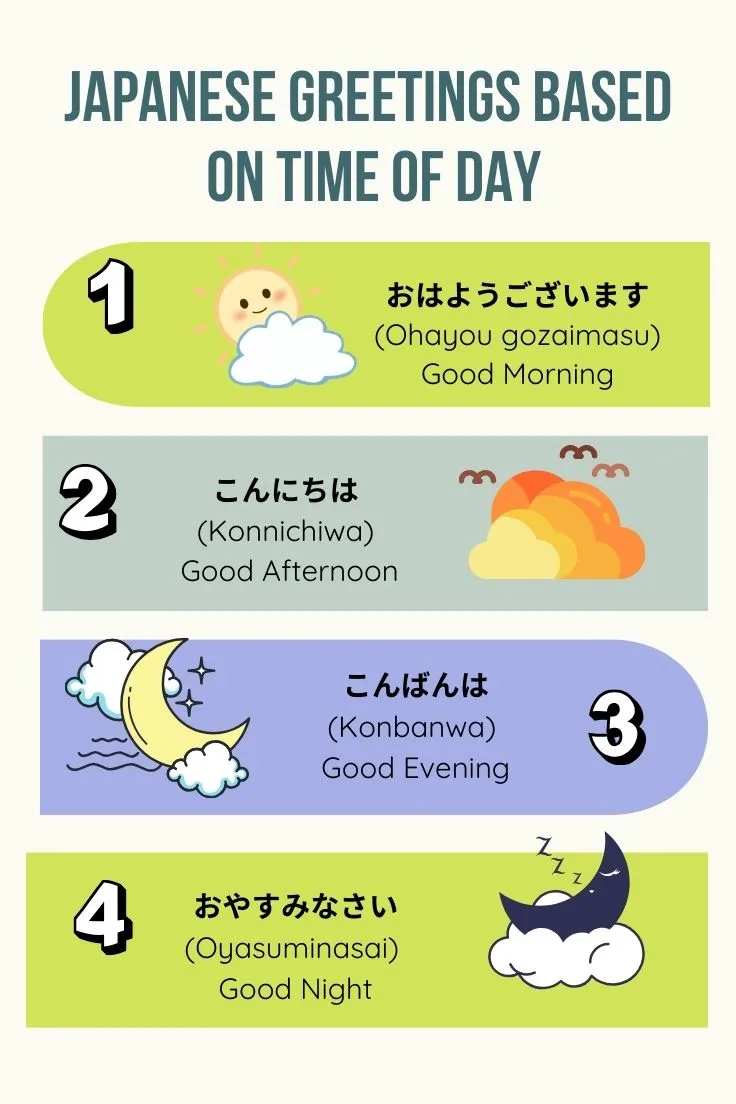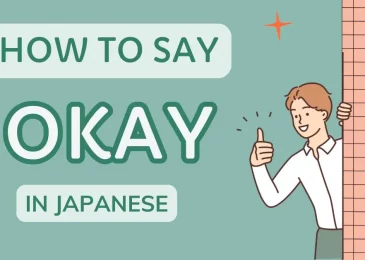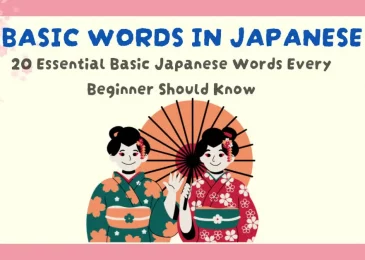In Japan, greetings play a crucial role in establishing respect and setting the tone for any conversation. Whether you’re meeting a friend, a colleague, or a business partner, knowing how to say “Good Afternoon” properly is essential to demonstrating politeness. However, the way you greet someone can vary depending on the context and the level of formality required.
This comprehensive guide will explain how to say “Good Afternoon” in Japanese, with cultural insights, common expressions, and practical examples. By the end of this article, you’ll have a deeper understanding of Japanese greetings and how to use them in everyday conversations.
- How to Say “Good Afternoon” in Japanese
- When to Use “Konnichiwa”
- Variations of “Good Afternoon” in Japanese
- Japanese Greetings Based on Time of Day
- Other Common Japanese Greetings
- The Cultural Significance of Greetings in Japan
- Example Dialogues Using “Konnichiwa”
- Conclusion
Explore communication courses:
1. How to Say “Good Afternoon” in Japan
The most common translation for “Good Afternoon” in Japan is 「こんにちは」 (pronounced konnichiwa). This word is used in various settings, from casual encounters to more formal situations, and is one of the most widely recognized Japanese greetings. Despite being translated as “Good Afternoon,” konnichiwa can also be used as a general greeting throughout the day, typically from late morning until early evening.
Pronunciation:
- こんにちは (konnichiwa)
- IPA: /konnichiwa/
Literal Meaning:
While konnichiwa literally translates to “good day” or “hello,” it is commonly used as “Good Afternoon” in the afternoon hours.
2. When to Use “Konnichiwa” – Good Afternoon in Japan
The use of “good afternoon” in Japanese – Konnichiwa is versatile, but it’s mainly used between 11 a.m. and 5 p.m., during the afternoon period. However, it’s essential to understand that this greeting is not limited strictly to the afternoon – it can be used anytime during the day as a general greeting, especially if you’re unsure of the time.
Example Situations:
Casual Greeting: When meeting a friend or a colleague during the afternoon, you might say:
Konnichiwa, Tanaka-san!
(こんにちは、田中さん!)
Hello, Mr. Tanaka!
Formal Greeting: At a business meeting, you might greet someone with:
Konnichiwa, Ogenki desu ka?
(こんにちは、お元気ですか?)
Good afternoon, how are you?

To learn how to say “Good afternoon” in Japan, MochiKanji’s conversation course is the perfect solution. MochiKanji effectively enhances your Japanese speaking skills, including mastering phrases like “good afternoon” in Japanese. Moreover, the program offers interactive lessons and real-life scenarios, helping you confidently communicate in various settings.
3. Variations of “Good Afternoon” in Japan
While konnichiwa is the most widely used greeting for the afternoon, there are other variations to saying “good afternoon” in Japanese depending on formality, social setting, or even time of day. Let’s explore a few alternatives:
Good Day / Hello
おはようございます (Ohayou gozaimasu)
This is a formal greeting used to say “Good Morning.” However, it is not typically used for the afternoon. But, in some contexts, it can still be heard if you are greeting someone earlier in the day.
For Business or Formal Settings:
In more formal situations, konnichiwa might be followed by phrases like:
- 失礼いたしますが (Shitsurei itashimasu ga)
Excuse me, but…
For Older People or Superiors:
- ご機嫌いかがですか (Gokigen ikagadesu ka)
This is an even more formal way to ask, “How are you?” It’s typically used when addressing superiors or elders.
4. Japanese Greetings Based on Time of Day

Although konnichiwa is a go-to expression for saying “Good afternoon” in Japan, Japanese greetings are often tied to specific times of day. Understanding when to use certain greetings helps ensure your interactions are respectful and context-appropriate.
Morning (Before 11 a.m.)
おはようございます (Ohayou gozaimasu)
This is the formal way of saying “Good Morning.” In informal settings, you can simply say おはよう (Ohayou).
Afternoon (11 a.m. to 5 p.m.)
こんにちは (Konnichiwa)
The standard greeting for “Good Afternoon”
Evening (After 5 p.m)
こんばんは (Konbanwa)
This means “Good Evening” and it’s used once the day is nearing its end, typically after 5 or 6 p.m.
Night (Late evening)
おやすみなさい (Oyasuminasai)
This is used to say “Good Night” before going to bed. It’s a polite expression, and in informal settings, you can simply say おやすみ (Oyasumi).
5. Other Common Japanese Greetings
Beyond just “Good Afternoon,” here are a few other essential Japanese greetings that you may encounter in daily life:
How are you?
お元気ですか (Ogenki desu ka?)
This is a formal way to ask someone “How are you?”
Example:
Konnichiwa, Tanaka-san! Ogenki desu ka?
Hello, Mr. Tanaka! How are you?
Nice to Meet You
はじめまして (Hajimemashite)
This is used when meeting someone for the first time. You typically follow this phrase with よろしくお願いします (Yoroshiku onegaishimasu), which means “Please treat me well” or “I look forward to working with you.”
Goodbye
さようなら (Sayounara)
The most common word for “Goodbye” in Japanese, though it’s typically reserved for more formal or final farewells.
6. The Cultural Significance of Greetings in Japan
Japanese culture places great importance on greetings and the appropriate level of politeness. The formality of your greeting can convey respect for the person you are addressing, and it helps establish social hierarchies in the conversation.
Politeness and Formality
In Japan, how you greet someone can change based on your relationship. A simple greeting like konnichiwa might be acceptable for peers or strangers, but if you’re speaking to someone of higher status (such as a superior at work), you would opt for more formal language.
Body Language
Along with verbal greetings, body language is an important part of Japanese communication. Bowing is a common practice that accompanies greetings in Japan. The depth and duration of the bow depend on the formality of the situation.
Exchanging Business Cards
In business settings, a greeting is often followed by an exchange of business cards, especially during formal introductions. It’s customary to receive and give cards with both hands and to show respect for the card by looking at it briefly before putting it away.
7. Example Dialogues Using “Good Afternoon” in Japan – Konnichiwa
To better understand how to use konnichiwa, here are a few practical examples of dialogues you may encounter:
Example 1: Informal Greeting
- A: こんにちは!元気ですか? (Konnichiwa! Genki desu ka?)
Hello! How are you? - B: こんにちは!元気だよ、ありがとう! (Konnichiwa! Genki da yo, arigatou!)
Hello! I’m doing well, thank you!
Example 2: Formal Greeting
- A: こんにちは、田中さん。お元気ですか? (Konnichiwa, Tanaka-san. Ogenki desu ka?)
Good afternoon, Mr. Tanaka. How are you? - B: こんにちは、おかげさまで元気です。 (Konnichiwa, okagesama de genki desu.)
Good afternoon, I’m doing well, thanks to you.
Conclusion
Saying “Good Afternoon” in Japan is more than just a simple exchange of words—it’s an important part of understanding and respecting Japanese culture. Konnichiwa serves as a versatile greeting that can be used in a variety of contexts, but it’s essential to be aware of the different variations and when to use them. By learning how to use greetings appropriately, you can enhance your ability to communicate with respect and build better relationships in Japan.
Whether you’re visiting Japan, learning Japanese, or simply interested in Japanese culture, mastering these common greetings will undoubtedly enhance your language skills and cultural understanding. So, the next time you greet someone in the afternoon, remember to say “Konnichiwa!”





